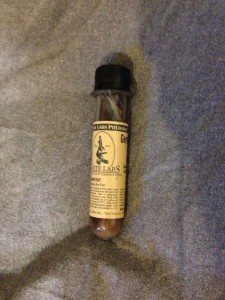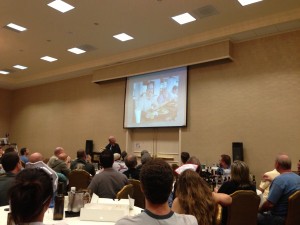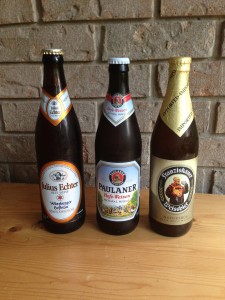Late last year, I attended the Dixie Cup in Houston. One of the speakers was Dr. Chris White, the founder of White Labs Yeast. He spoke about several things White Labs was doing, including opening a tasting room, but for me the most interesting part of his talk involved some experiments with yeast strains and IBUs.
White and his staff made up a standard wort, with a known (calculated) level of bitterness, and fermented aliquots of it with each of the White Labs strains. Each beer was then analyzed for its actual level of bitterness (in IBUs). He then compared the measured IBUs to the predicted IBUs for each strain. If the two were equal, the beer was given a score of 1. If the measured IBUs were less than the predicted IBUs, the beer received a score between zero and one. For example, if the beer was expected to have 100 IBUs, but only had 80, the beer would be given a 0.8. (Note: the experiment wasn’t done with 100 IBU beers, I just used that number as an example because it’s easy to see how the proportions worked out.) And if the beer was more bitter than predicted, the beer received a number over 1.
Dude, Where’s my IBUs?
Interestingly, over two thirds of the yeast strains received below a 1. The strains that scored among the lowest — WLP029 (German Ale/Kölsch), WLP300 (Hefeweizen Ale) and WLP 380 (Hefeweizen IV Ale) — scored around 0.5. In other words, the level of bitterness was half what the recipe calculator predicted! Other strains that scored under 1 include WLP002 (English Ale) and WLP041 (Pacific Ale) yeast. Interestingly, these were already described as leaving a malty profile.
Hoppy Strains
It should come as no shock that among the strains that scored 1 or above were the strains frequently used in American-style IPAs. White Labs WLP001 (California Ale), White Labs most popular strain, scored around 1, as did WLP550 (Belgian Ale) yeast. Strains that were slightly above 1 include WLP005 (British Ale), WLP810 (San Francisco Lager), WLP830 (German Lager), WLP860 (Munich Helles), WLP039 (East Midlands Ale) and WLP862 (Cry Havoc).
What’s Happening to the Hops?
It’s been known for a long time that yeast takes some of the bitterness out of worts. That’s why, for instance, Vinnie Cilurzo of Russian River recommends slightly underpitching beers that are meant to be intensely hoppy. Exactly how this occurs is not known. It may have something to do with the electrical charges on iso-alpha acid and the charges of proteins embedded in the yeast cell wall. When the yeast flocculate, they may pull iso-alpha acids with them.
What Should You Do?
Now that you know that some yeast strains may be bogarting your IBUs, what should you do? Well, if you’re following a recipe that someone else has actually brewed and liked, follow the recipe. Whatever effect the yeast has will have been counteracted by the brewer adjusting the hop amounts to get the right flavor and aroma. If you’re formulating your own recipes from scratch, be aware that you might have to adjust the amount of hops upward to get the level of bitterness you’re looking for.
It’s probably no coincidence that some of the strains that scrub the most IBUs from the wort are usually used in beer styles that aren’t very bitter. And likewise, most super-hoppy recipes use clean ale yeasts, which many of the strains rated around 1 were.
The differences among strains could be interesting when making hybrid style beers, like hoppy hefeweizens of Belgian IPAs.
White plans to release the numbers when he and his lab has tested the yeast strains all again to see if the results are repeatable. Once these numbers become available, they can simply be incorporated into recipe calculation spreadsheets and help brewers better formulate their beers.

In the future, yeast strains may be labeled with a bitterness ranking, just as the alpha acid content is reported for hops.
—
Related articles
Hoppy American Ales: Fermentation



I am wondering if there are Wyeast equivalents to these strains? I live in Oregon so we are pretty dominated by Wyeast here, but I am not complaining.
See the comment below. There is an equivalency chart at mrmalty.com.
Kristen England put out a chart mapping the supposed equivalents.
http://www.mrmalty.com/yeast.htm
Both Greg Doss of Wyeast and Stan Hieronymous have talked about the same thing. Based on Stan’s work, I’ve started moving beers to secondary before dry hopping to reduce the amount of interaction between yeast and hops.
If the prevailing theory is an electric charge on the isomerized alpha acids, I wonder if there would be any effect at all on hops that were never boiled? Intuitively to me, it seems more likely that its simply hop oil molecules physically coating the yeast cells (and any other particulates in solution) and falling out of solution with whatever it has coated. I believe this is how it is thought hops get their antiseptic properties- the oil forms a layer on the outside of the cell and prevents passage across the cell membrane.
Have you done any side-by-side comparisons for dry hopping before/after secondary to see if there is any difference? Might make for a neat easy little experiment. I don’t stay up much on dry hop literature, as its not a technique I use.
– Dennis, Life Fermented Blog
Personally I don’t care about IBU contribution from dry hoppin although I realize it is connected to oils that contain aromatic and flavor compounds. However flavors dry hopped in the presence of yeast can be changed. Not necessarily for better or worse, just different. I do find some of those flavors quite unique and pleasent as can really add to the complexity.
Did either of them have numbers to put to individual strains? It would be interesting to see how they compare.
Very cool! Is there a spreadsheet or list of the yeast and their final IBU factors available to view?
Dr. White is waiting to replicate the results before he releases the study. The numbers he gave at the Dixie Cup preliminary (based on one round of testing, I believe). Once they become available, we’ll cover it.
This is interesting research. I would be interested to see the same study with a ppm level of iso-alpha-acids (IAA) pre-pitching and finished fermentation with uniform pitching rates for each strain.
That would be cool — and a ton of work.
Chris,
I was wondering if there have been any updates on this. I recall another primary source which contained strain specific references, but for the life of me, I can’t find it now.
Aaron
No updates yet, but according the Chris White, they’ll publish when they have a solid data set. I know that many homebrewers — including myself — will be interested in seeing this.